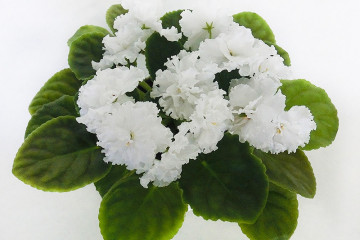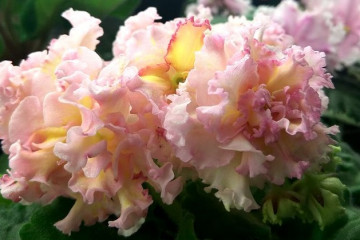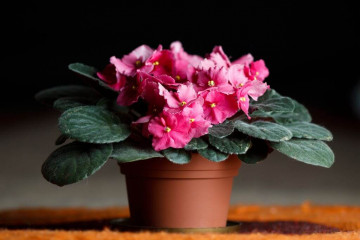Violet Fairy - description and characteristics of the variety
Content:
The violet fairy is one of the varieties of culture, which is distinguished by its delicate color and shape of flowers. Despite the fact that there are many varieties, it stands out noticeably from the rest. But in order for this uzumbar violet to bloom steadily and fully develop, it is necessary to study the basic rules of care and maintenance, and also to get acquainted with what problems you will have to face.
What does a violet Fairy look like
This plant, like other species, has its own characteristic differences. But, according to experienced florists, Saintpaulia Fairy is suitable for everyone who wants to create an atmosphere of comfort and warmth in the house.
The fairy, like other varieties of Uzumbar violets, is a perennial herb with a creeping rhizome. The plant forms an even, compact rosette of basal leaves. Its height reaches 15 cm.
The main stem is short, 1.5-2 cm in diameter. The leaves of Saintpaulia Fairy are straight, regular, quilted. The surface of the plates is glossy; along the edge they are slightly wavy.
Violet Fairy is one of the representatives of the Gesneriaceae family. Its close relatives are the following plants:
- gloxinia;
- color scheme;
- eschinantus;
- sinningia;
- gesneria.
Briefly about the history of appearance
This variety was officially announced in 2012, when it was first presented at an exhibition in Moscow. The presentation of the new variety was made by the Russian breeder Tatyana Lvovna Dadoyan.
Initially, she was engaged in breeding new species at an amateur level. But when I heard the opinion that all possible variants in breeding had already been tried, I decided to prove the opposite.
As a result of her work, not only the Fairy variety was obtained, but also 10 others. All of them are distinguished by incredible shades of colors and a beautiful appearance of the outlet.
Features of caring for a violet Fairy Dadoyan at home
Despite the fact that the care for the Usambar violets is the same, the Fairy requires certain rules to be followed when growing. It is better to study them in advance so that later there will be no problems in growing this variety of Saintpaulias.
Temperature
The description says that for full growth and flowering, the Fairy needs a temperature of content within 16-23 degrees. At the same time, sharp drops should not be allowed.
At a temperature of +15 degrees, the growth of violets completely stops. With a further decrease, irreversible changes occur in plant tissues. The Fairy also does not tolerate high temperatures. If the maintenance regime is higher than the maximum allowable mark, the general appearance of the plant becomes dejected, the violet stops blooming, the leaves may turn yellow.
Lighting
The fairy needs good lighting, since not only her growth depends on this, but also the color of the flowers. Experienced growers recommend placing this variety on the eastern, western and northern windows, but at the same time exclude direct sunlight.
Watering
Watering should be carried out as the topsoil dries out. To do this, use settled water at room temperature.
Moisturizing can be done in the following ways:
- especially in the pan, adding several times so that the substrate can be saturated with water;
- lowering the pot into another container with water for 15-20 minutes;
- directly under the root with a watering can.
Spraying
The Fairy's leaves, like other types of violets, are slightly pubescent. Therefore, it is not recommended to spray the plant unless there is an urgent need. When moisture gets on the leaves, ugly yellow spots appear, which negatively affects the general appearance of the outlet.
Humidity
Favorable level of humidity for the growth of violets Fairy Dadoyan is in the range of 50-60%. If the value is below this mark, then it is recommended to place additional containers with water near the pot.
Priming
The fairy prefers a substrate with high acidity, which is based on peat. At the same time, it is important that the soil is loose, moisture and air permeable.
Top dressing
The fairy needs regular feeding. During the period of active growth of leaves and rosettes, it is necessary to use fertilizers with a high nitrogen content, and during the formation of buds and flowering, phosphorus-potassium fertilizers.
Top dressing from March to the end of September must be carried out every 10 days, and in the rest of the year 1 time in 2-3 weeks.
When and how it blooms
Fairy belongs to the bouquet plant species. During flowering, it forms a cap of flowers in the center of the rosette, which confidently rise above the leaves.
Fairy's shade of flowers is white with a pink tint in the center and a fuchsia lace border. But depending on the lighting, it can change. Most often, the bud, when opened, has a white tint, and bright colors are added only over time. In some cases, with a lack of light, the flowers open dark purple.
Flowers in this variety can be of different shapes. During the first flowering, they consist of 5 serrated petals, while the lower one is much wider than the rest, and the lateral ones are directed downward.
As the rosette matures, the Fairy's flowers become terry. In their form, they are in many ways similar to the Actress variety.
Under favorable conditions, this violet can bloom all year round. But most often, due to lack of light, only from March to October.
In the event of a hot summer, the Fairy stops flowering until the temperature drops to the required level.
Changes in care during flowering
During flowering, the Fairy cannot be rearranged to a new location.
Also, during this period, it is necessary to water the plant more often and make sure that there are no drafts.
How Saintpaulia Fairy reproduces
This variety is propagated by leaf cuttings. They must be cut from the second or third tier of the outlet at an oblique angle. After that, the cutting must be dried (2 hours), and then planted in separate cups filled with earth. The cuttings should be buried 3 cm in the soil.
In the future, small baby sockets will appear at the base. During this time, the cuttings should be watered regularly and made sure that the substrate does not dry out in the container. Rooting occurs after 3-4 weeks, and young plants will appear 2-3 months after that.
Transplant after purchase and during reproduction
It is necessary to transplant the Fairy as the outlet grows. To do this, you can buy the substrate in the store or prepare it yourself.
The soil mixture should consist of:
- 2 pieces of turf;
- 1 part peat;
- 2 parts of leafy soil;
- 1 part of coniferous litter;
- 1 part vermiculite.
The pot for planting also matters, its diameter should be 2 cm larger than the previous one. It is important that drainage holes are made in the bottom, which will exclude stagnant moisture.
Possible growing problems
Saintpaulia Fairy requires increased attention. At the same time, she reacts poorly to any mistakes in care. As a result, the plant's immunity is reduced.
Leaf problems
The appearance of yellow spots on the leaves can be associated with 2 reasons. In the first case, water got on them during watering, and in the second, burns appeared under the influence of direct sunlight.
Pests
Fairy can suffer from pests. In this case, the growth and development of the plant will be slowed down. In addition, the violet will not be able to bloom fully until the problem is completely eliminated.
Fairy's main pests:
- Spider mite. A lesion can be recognized by the slow growth of the central part of the rosette. In addition, the leaves are covered with a light yellowish bloom, and subsequently a thin cobweb. To destroy the pest, it is necessary to spray the violet twice at intervals of 7 days with Aktellik or Fitoverm.
- Thrips. Small harmful insects that feed on leaf sap. As a result, the plates are deformed, and their edges are tucked down. To combat thrips, it is recommended to use "Inta-Vir" or "Iskra".
Diseases
The fairy can also suffer from various diseases. The most common ones are:
- Powdery mildew. It manifests itself as a white bloom on the leaves, which subsequently takes on a brown tint. As a result, the process of photosynthesis is disrupted. The leaves eventually wither completely. For treatment it is recommended to use: "Topaz", "Speed".
- Root rot. It develops as a result of stagnant moisture in combination with a low temperature of the content. The disease can be recognized by the loss of turgor in the leaves, which indicates a malnutrition. You can save the plant if you root the top of the outlet or leaf cuttings in a timely manner.
Signs of improper care
When growing violets Fairy, you must comply with the basic requirements of the culture. Otherwise, lush bloom will never come.
General signs of care errors:
- depressed view of the outlet;
- the buds dry out without opening;
- sluggish leaves;
- the surface of the plates does not shine;
- slow growth or its complete absence;
- deformed sheet plates.
Violet Fairy is an unusual variety that, when properly grown, amazes with the beauty of its flowers. But in order to achieve such a result, you must strictly adhere to the rules of care. Otherwise, flowering may never come or it will be very scarce, and a fan of indoor plants will not understand why this is happening.



















